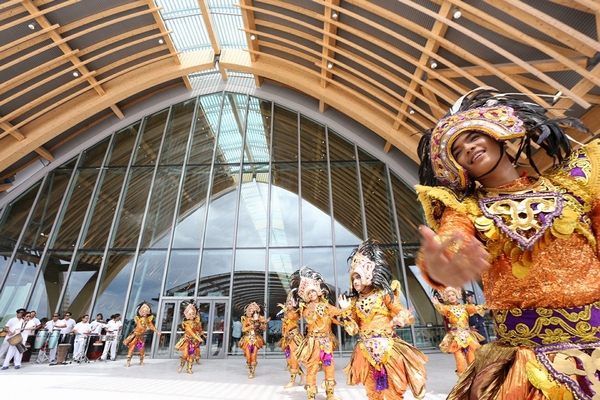
Sinulog dancers welcome guests at the departure area entrance during the inauguration of the Mactan Cebu International Airport Terminal 2.
What can passengers expect at the world’s first ever resort airport?
From inside out, the new Terminal 2 of the Mactan Cebu International Airport (MCIA) is designed and engineered to convey the “warmth” of Cebu as a destination as well as its people.
Internationally renowned designer Kenneth Cobonpue, one of the designers of the Terminal 2, explained that they wanted to showcase Cebu’s culture in the design of the P17.5-billion facility that was inaugurated last June 7.
Probably its most notable feature is wooden roof arches that spans every 30 meters. It is made of glulam or glue-laminated timber that is said to be stronger than steel and sustainable.
“As to the choice of wood, it’s because most of the airports around the world are very cold. We wanted to make it warm so it feels like you are coming home,” he told Cebu Daily News.
Portions of the roof, and the facade of the terminal is made of layers of tempered glass that allows natural light to come in without the heat, and for passengers to feel the palpable warmth even while inside the facility.
The departure area of the new terminal.
Characteristics of beaches
Dubbed as the world first and “friendliest” resort airport, the MCIA Terminal 2 also features characteristics of beaches which Cebu is very much known for.
The undulating roof is reminiscent of the waves of Cebu’s beautiful beaches. Even the ceilings inside the terminal have formations similar to waves.
“If you’re inside, the roof also looks like the wooden hull of a boat. It’s because fishing and boat-building is integral in the lives of Cebuanos,” Cobonpue explained.
Another well-thought of component of the airport is its interior flooring. Mother-of-pearl shards are actually embedded in the terrazzo flooring, that makes it glisten like the sand of Cebu’s beaches.
When the natural sunlight comes in and hits the floor, it sparkles like white sand. It took about 12 polishings to achieve this shine.
The comfort rooms of the terminal also feature mahogany wood and live moss walls, a little greenery that helps to stabilize humidity as well as improve air quality.
The new terminal, which will exclusively house all international flights to and from Cebu, will have 48 check-in counters which can be expanded to 72.
Each of these counters have woven rattans that are backlit and can change colors depending on a season or activity, according to Cobonpue.
The 65,500-square meter terminal is designed by Hong Kong-based Integrated Design Associates (IDA) together with local designers Budji Layug, Royal Pineda, and Cebu’s very own Cobonpue.
President Rodrigo Duterte led the inauguration of the terminal last June 7. It will start commercial operations on July 1.
Three levels
The terminal has three levels with the uppermost being the departures area.
After checking in, passengers will go through the immigration area and security check. Afterwards, they can check out the “walk-through” Duty Free Philippines outlet and other retail brands. The wide-ranging retail environment has approximately 3,000 square meters of gross leasable space.
The terminal’s F&B is operated by British company SSP Group which also operates in some of the world’s busiest airports like London’s Heathrow Airport, New York’s John F. Kennedy International Airport, and Thailand’s Suvarnabhumi Airport.
One floor down is where the actual boarding gates are located.
The ground floor is the arrivals area and baggage claim area that boasts of a high ceiling.
The entire terminal is equipped with 12 escalators and 15 elevators. A parking area is also available that can accommodate 550 cars and can be expanded to accommodate 750.
The world-class terminal is built by the consortium of Filipino engineering and infrastructure company Megawide and leading Indian infrastructure company GMR which formed the GMR-Megawide Cebu Airport Corporation (GMCAC).
GMCAC took over landside operations of the MCIA on November 1, 2014 under a 25-year Build-Transfer Operate agreement. They broke ground for the construction of Terminal 2 on June 29, 2015.
MCIA’s Terminal 2 is expected to increase the airport’s capacity to 12.5 million passengers a year.
“We are committed to delivering a world-class travel experience to the public with our signature Filipino warmth,” said GMCAC President Louie Ferrer.
“We want the experience at the airport to be as positive and as memorable as its destination, Cebu,” he added.